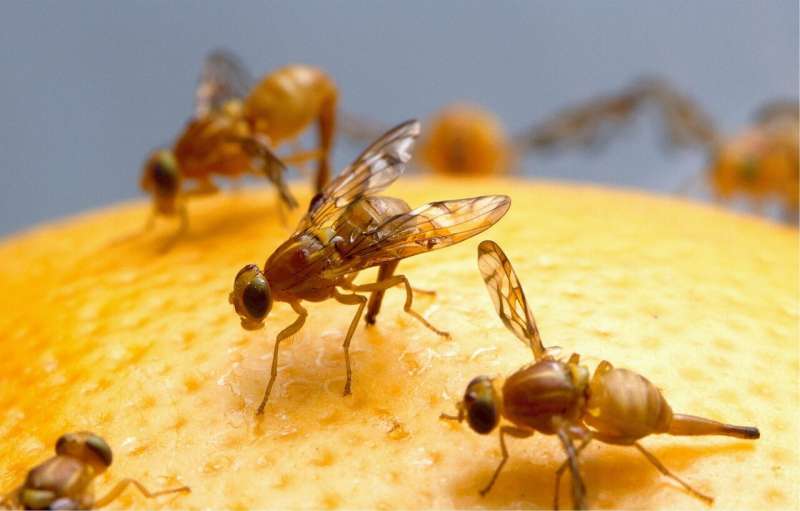A timekeeper for siesta

Circadian clocks must be flexible and they must be able to adapt to varying environmental conditions. Otherwise, it would be impossible for living beings to change their patterns of activity when the days get shorter again as is happening now. After all, Drosophila, also known as the common fruit fly, no longer needs a long siesta in autumn to protect itself from excessive heat and predators as in the middle of summer. At the same time, the fly must shift its evening activity peak a few hours forward if it doesn't want to end up buzzing around in the dark.
For the fruit fly to adapt to changing day-and-night rhythms, its circadian clock must be able to process external cues, so-called zeitgebers, which are used to synchronise the molecular and physiological properties of the organism. Light is the most important zeitgeber the fly uses for this.
Scientists from the Department of Neurobiology and Genetics at the University of Würzburg have been researching the interaction of light, photoreceptors and circadian clocks in the fruit fly for some time. Chair holder, Charlotte Förster, together with her former colleague Matthias Schlichting, who presently works at Brandeis University (Massachusetts, U.S.), have now figured out new and surprising details of this interaction. They present the results of their research in the current issue of Current Biology.
"In mammals, a combination of the traditional photoreceptor pathway (rods and cones of the retina) and the circadian photoreceptor melanopsin in retinal ganglion cells enables the fine-tuning of clock synchronisation," Charlotte Förster explains. She says that there is a comparable mechanism in Drosophila: "The compound eyes, the extraretinal Hofbauer-Buchner eyelets and the circadian photoreceptor cryptochrome all work together in the light synchronisation process," the professor summarises the central result of the recently published study.
It is known from earlier studies how the photoreceptor cryptochrome works. Located in special nerve cells, the so-called clock neurons, it interacts with the timeless clock protein during light exposure, leading to the degradation of the protein. Figuratively speaking, it turns the clock back to zero. However, less is known about the exchange between the eyes of the fruit fly and the clock neurons and how the different day length is mediated.
Experiments with different day lengths
For their study, the scientists worked with different specimens of fruit flies. They used healthy flies, eyeless flies and flies lacking specific visual pigments of the eye, the so-called rhodopsins. During the laboratory experiments, the insects were exposed to different light conditions: At a constant day length of 24 hours, the researchers extended the period of light in two-hour increments from twelve to a maximum of 20 hours and observed the activity patterns of the respective fly groups.
It turned out that the activity of the insects changed with increasing length of the daylight period. When periods of light and darkness alternate regularly every twelve hours, which corresponds to a typical day at the equator, healthy flies become active twice: around the time of "sunrise" and before the simulated "sunset". As the days get longer, the evening activity is also delayed and the "siesta"—the midday resting period—is extended. It is striking though that as the periods of daylight increase, the activity peak in the evening deviates from the simulated sunset and is much earlier in some cases. The largest deviation occurs when the daylight period is 20 hours long, probably because the flies are never confronted with such conditions in their natural environment.
Discovery in the compound eye
While searching for the molecular and neuronal mechanisms which the fruit fly uses to fine-tune its circadian clock in a manner of speaking, the neurobiologists had to carry out numerous experiments. Experiments on fruit flies that lacked these eyes demonstrated that the compound eyes play a key role. Their activity peak was also delayed as the length of the daylight period increased, but much less so than in their seeing relatives. More experiments were conducted to pinpoint which receptor cell and visual pigment are responsible for this. After all, each facet of the fly's compound eye has eight receptor cells and five rhodopsins. So the scientists selectively switched off the individual cells until it was clear that receptor cell 8 and rhodopsins 5 and 6 which occur there were their targets.
The scientists next investigated how the light signal reaches the brain of the fruit fly and how it travels from there to the clock neurons. Surprisingly, they found that while the signal is transported via so-called "small lateral clock neurons" during "moderate" light periods, it travels through "large lateral clock neurons" in the 20-hour light experiments. "Although the circadian clock of the fruit fly is comparatively small with just 150 neurons, the overall system has high plasticity," Charlotte Förster recapitulates the results of the study and she explains that this neuronal plasticity is necessary to enable the animals to quickly adjust to varying conditions.
More information: Matthias Schlichting et al. Light-Mediated Circuit Switching in the Drosophila Neuronal Clock Network, Current Biology (2019). DOI: 10.1016/j.cub.2019.08.033
Journal information: Current Biology
Provided by University of Würzburg


















